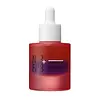What's inside
What's inside
 Key Ingredients
Key Ingredients

 Benefits
Benefits

 Concerns
Concerns

 Ingredients Side-by-side
Ingredients Side-by-side

Water
Skin ConditioningOrbignya Oleifera Seed Oil
EmollientPrunus Amygdalus Dulcis Oil
Skin ConditioningVitis Vinifera Seed Oil
EmollientAdansonia Digitata Seed Oil
EmollientPassiflora Edulis Seed Oil
EmollientGlycerin
HumectantCucurbita Pepo Seed Oil
EmollientHelianthus Annuus Seed Oil
EmollientPrunus Armeniaca Kernel Oil
MaskingPrunus Persica Kernel Oil
EmollientBakuchiol
AntimicrobialPalmitoyl Tripeptide-1
Skin ConditioningAcetyl Hexapeptide-8
HumectantCopper Tripeptide-1
Skin ConditioningSodium Hydroxide
BufferingCaprylic/Capric Triglyceride
MaskingCetyl Ethylhexanoate
EmollientGluconolactone
Skin ConditioningLimonene
PerfumingBrassica Campestris Seed Oil
Skin ConditioningSodium Benzoate
MaskingPolyglyceryl-3 Laurate
EmulsifyingGlycyrrhiza Glabra Root Extract
BleachingPolyglyceryl-3 Diisostearate
EmulsifyingCrithmum Maritimum Extract
Skin ConditioningTocopherol
AntioxidantAlthaea Officinalis Root Extract
Skin ConditioningOryza Sativa Bran Extract
Skin ConditioningMethyl Glucose Sesquistearate
EmollientCitrus Nobilis Peel Oil Expressed
PerfumingCalcium Gluconate
HumectantEthylhexyl Palmitate
EmollientLinalool
PerfumingTribehenin
EmollientSorbitan Isostearate
EmulsifyingWater, Orbignya Oleifera Seed Oil, Prunus Amygdalus Dulcis Oil, Vitis Vinifera Seed Oil, Adansonia Digitata Seed Oil, Passiflora Edulis Seed Oil, Glycerin, Cucurbita Pepo Seed Oil, Helianthus Annuus Seed Oil, Prunus Armeniaca Kernel Oil, Prunus Persica Kernel Oil, Bakuchiol, Palmitoyl Tripeptide-1, Acetyl Hexapeptide-8, Copper Tripeptide-1, Sodium Hydroxide, Caprylic/Capric Triglyceride, Cetyl Ethylhexanoate, Gluconolactone, Limonene, Brassica Campestris Seed Oil, Sodium Benzoate, Polyglyceryl-3 Laurate, Glycyrrhiza Glabra Root Extract, Polyglyceryl-3 Diisostearate, Crithmum Maritimum Extract, Tocopherol, Althaea Officinalis Root Extract, Oryza Sativa Bran Extract, Methyl Glucose Sesquistearate, Citrus Nobilis Peel Oil Expressed, Calcium Gluconate, Ethylhexyl Palmitate, Linalool, Tribehenin, Sorbitan Isostearate
Water
Skin ConditioningGlycerin
HumectantButylene Glycol
HumectantPentylene Glycol
Skin ConditioningPolyglyceryl-6 Stearate
EmollientCaprylic/Capric Triglyceride
MaskingPanthenol
Skin ConditioningDicaprylyl Carbonate
EmollientDicaprylyl Ether
EmollientPotassium Cetyl Phosphate
EmulsifyingPolyglyceryl-6 Behenate
Emulsion StabilisingTetrapeptide-21
Skin ConditioningPalmitoyl Tripeptide-1
Skin ConditioningPalmitoyl Tetrapeptide-7
Skin ConditioningPalmitoyl Tripeptide-38
Skin ConditioningCopper Palmitoyl Heptapeptide-14
Skin ConditioningHeptapeptide-15 Palmitate
Skin ConditioningSaccharide Isomerate
HumectantAllantoin
Skin ConditioningCetearyl Alcohol
EmollientGlyceryl Stearate Se
EmulsifyingTapioca Starch
Acrylates/C10-30 Alkyl Acrylate Crosspolymer
Emulsion StabilisingCarbomer
Emulsion StabilisingPolysorbate 20
EmulsifyingHydroxypropyl Cyclodextrin
MaskingLactic Acid/Glycolic Acid Copolymer
Skin ConditioningPolyvinyl Alcohol
Citric Acid
BufferingSodium Citrate
BufferingSodium Hydroxide
BufferingPhenoxyethanol
PreservativeEthylhexylglycerin
Skin ConditioningWater, Glycerin, Butylene Glycol, Pentylene Glycol, Polyglyceryl-6 Stearate, Caprylic/Capric Triglyceride, Panthenol, Dicaprylyl Carbonate, Dicaprylyl Ether, Potassium Cetyl Phosphate, Polyglyceryl-6 Behenate, Tetrapeptide-21, Palmitoyl Tripeptide-1, Palmitoyl Tetrapeptide-7, Palmitoyl Tripeptide-38, Copper Palmitoyl Heptapeptide-14, Heptapeptide-15 Palmitate, Saccharide Isomerate, Allantoin, Cetearyl Alcohol, Glyceryl Stearate Se, Tapioca Starch, Acrylates/C10-30 Alkyl Acrylate Crosspolymer, Carbomer, Polysorbate 20, Hydroxypropyl Cyclodextrin, Lactic Acid/Glycolic Acid Copolymer, Polyvinyl Alcohol, Citric Acid, Sodium Citrate, Sodium Hydroxide, Phenoxyethanol, Ethylhexylglycerin
 Reviews
Reviews

Alternatives
Ingredients Explained
These ingredients are found in both products.
Ingredients higher up in an ingredient list are typically present in a larger amount.
This ingredient is an emollient, solvent, and texture enhancer. It is considered a skin-softener by helping the skin prevent moisture loss.
It helps thicken a product's formula and makes it easier to spread by dissolving clumping compounds.
Caprylic Triglyceride is made by combining glycerin with coconut oil, forming a clear liquid.
While there is an assumption Caprylic Triglyceride can clog pores due to it being derived from coconut oil, there is no research supporting this.
Learn more about Caprylic/Capric TriglycerideGlycerin is already naturally found in your skin. It helps moisturize and protect your skin.
A study from 2016 found glycerin to be more effective as a humectant than AHAs and hyaluronic acid.
As a humectant, it helps the skin stay hydrated by pulling moisture to your skin. The low molecular weight of glycerin allows it to pull moisture into the deeper layers of your skin.
Hydrated skin improves your skin barrier; Your skin barrier helps protect against irritants and bacteria.
Glycerin has also been found to have antimicrobial and antiviral properties. Due to these properties, glycerin is often used in wound and burn treatments.
In cosmetics, glycerin is usually derived from plants such as soybean or palm. However, it can also be sourced from animals, such as tallow or animal fat.
This ingredient is organic, colorless, odorless, and non-toxic.
Glycerin is the name for this ingredient in American English. British English uses Glycerol/Glycerine.
Learn more about GlycerinPalmitoyl Tripeptide-1 is also known as pal-GHK. It is made up of 3 amino acids and palmitic acid, a fatty acid that helps it absorb into skin more easily.
This peptide is as a signal peptide, meaning it tells the skin to produce more collagen. Collagen is the key protein that helps form the skin's structure and keep it plump, firm, and hydrated.
By boosting collagen production, this ingredient supports a stronger skin barrier and helps reduce the appearance of wrinkles.
You'll most likely see this ingredient paired with Palmitoyl Tetrapeptide-7 in the well-known Matrixyl 3000 complex. While results from in-house testing should be viewed cautiously, this peptide duo is among the most studied and widely used in modern skincare.
Due to its palmitic acid base, this ingredient may not be safe for Malassezia folliculitis.
Read more about other common types of peptides here:
Learn more about Palmitoyl Tripeptide-1Sodium Hydroxide is also known as lye or caustic soda. It is used to adjust the pH of products; many ingredients require a specific pH to be effective.
In small amounts, sodium hydroxide is considered safe to use. However, large amounts may cause chemical burns due to its high alkaline.
Your skin has a natural pH and acid mantle. This acid mantle helps prevent harmful bacteria from breaking through. The acid mantle also helps keep your skin hydrated.
"Alkaline" refers to a high pH level. A low pH level would be considered acidic.
Learn more about Sodium HydroxideWater. It's the most common cosmetic ingredient of all. You'll usually see it at the top of ingredient lists, meaning that it makes up the largest part of the product.
So why is it so popular? Water most often acts as a solvent - this means that it helps dissolve other ingredients into the formulation.
You'll also recognize water as that liquid we all need to stay alive. If you see this, drink a glass of water. Stay hydrated!
Learn more about Water